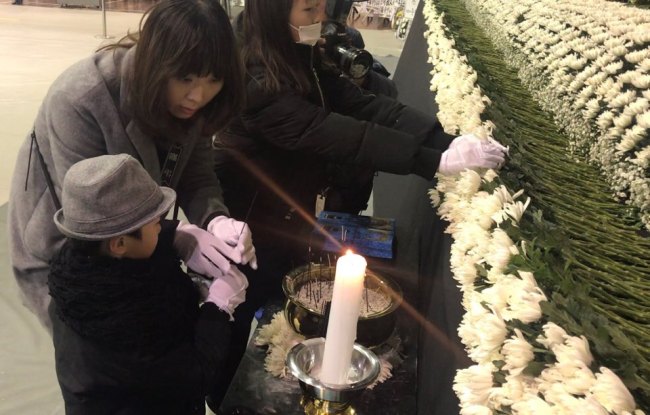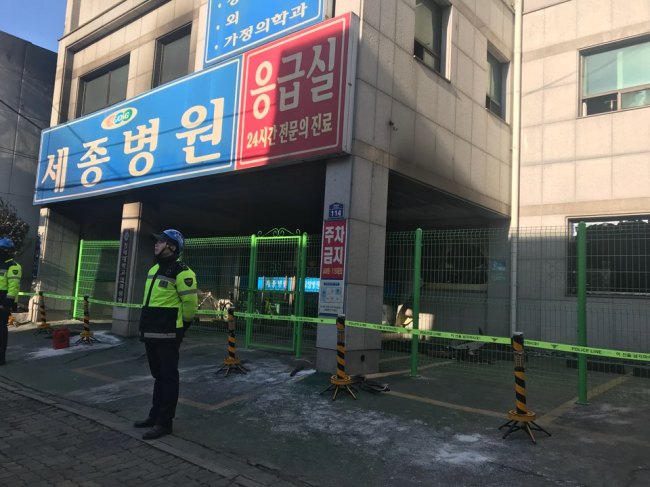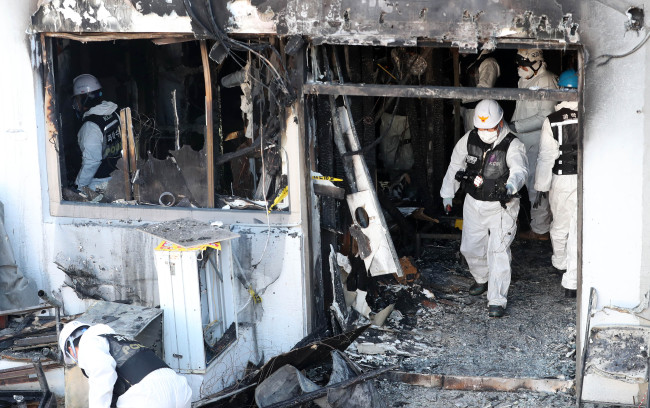[From the scene] Sorrow continues to run deep in Miryang
Victim, family and friends mourn loss of loved ones in the deadly fire that killed 39
By Bak Se-hwanPublished : Jan. 30, 2018 - 13:47
MIRYANG, South Gyeongsang Province -- When Sohn Eun-gi, 29, heard the news of a fire at Sejong Hospital in Miryang, South Gyeongsang Province, last Friday, Sohn had no doubt his grandmother had been safely evacuated -- until she wasn’t. His grandmother, Park Bong-gi, 96, died from smoke inhalation in a deadly blaze that killed 39 and injured 151.
“My grandmother was scheduled to leave the hospital today after months of recovery. We just weren’t ready for this,” Sohn told The Korea Herald at a local funeral home near Sejong Hospital on Monday. “I heard she had dedicated her life to raising my father and his seven brothers and sisters. Now that she’s gone, things will never be the same again as we cannot look after her anymore,” Sohn said.
“My grandmother was scheduled to leave the hospital today after months of recovery. We just weren’t ready for this,” Sohn told The Korea Herald at a local funeral home near Sejong Hospital on Monday. “I heard she had dedicated her life to raising my father and his seven brothers and sisters. Now that she’s gone, things will never be the same again as we cannot look after her anymore,” Sohn said.

When the blaze engulfed the first floor of the six-story building, most of the 99 patients staying there were in their 70s or older, unable to move on their own. Another 78 residents in the adjoining nursing home were all safely evacuated.
Like many rural cities, Miryang, some 350 kilometers southeast of Seoul, has a rapidly ageing population. Nearly one out of four who live there among the population of 107,898 are aged 65 or older as of last December, according to the city, as its young migrate to larger cities seeking employment.
The blaze quickly sent up dense plumes of smoke throughout the hospital 30 minutes after it broke out at around 7:30 a.m., according to a janitor who was on the fifth floor at the time of the fire.
“I was inside one of the wards when people started shouting about the fire on the first floor. The smoke was so thick outside the corridor, I couldn’t see anything in front of me. I just waited until firemen arrived and helped me escape down a rescue ladder,” said the janitor who spoke on condition of anonymity and is currently hospitalized at another nearby hospital.
The janitor helped one elderly patient there to breathe through wet towels, covering their noses and mouths while they waited for the firefighters. She said she wishes she could have saved more victims.
“I tried to look for fire extinguishers that were located on each floor, but I soon gave up because I just couldn’t see anything but hear the desperate screams of those trapped inside. I still can’t believe the building had no sprinklers at all,” the janitor said.
Deadly incidents renew worries about public safety
Public anger is mounting over the lack of safety standards and the government’s seemingly inept actions toward preventing yet another man-made disaster in the 11th largest economy in the world, just as the country prepares to host the Olympics next month.

The Miryang blaze occurred a month after 29 people died in a fire fueled by flammable cladding on the exterior of a fitness center building in Jecheon, North Chungcheong Province.
Also last week on Jan. 25, four subcontractors of Posco, South Korea’s top steelmaker, died of asphyxiation from a gas leak at a plant in Pohang, North Gyeongsang Province, a day before the Miryang fire.
When President Moon took office last May, he vowed to “make the country safer” and promised to improve safety standards.
The previous government’s alleged mishandling of the 2014 Sewol ferry sinking which claimed 304 lives, most of them schoolchildren on a field trip, was one of the several issues that sparked nationwide candlelight vigils against former President Park Geun-hye and her impeachment in March last year.
“The only difference so far between Park and Moon is that Moon shows more sympathy towards the loss of lives,” said a 62-year-old taxi driver in the city who said he voted for Moon. “But sympathy alone cannot bring back their lives,” he added. Moon made an unofficial visit to a joint altar for the fire victims in Miryang on Saturday to pay his respects.
The recent string of deadly incidents reveal similar problems that could go and went wrong, including lax regulations, according to experts.
“Fire sprinklers should be mandatory at all hospitals, along with other safety measures, as they react to fire faster than any other devices and help extinguish the fire immediately at the point of origin,” said Choi Kyu-chul, a former professor at Dongwon University’s fire safety department.
Loopholes exist in the current safety and fire prevention requirements, according to Choi, that vary according to the size of the hospital. In case of the relatively small-sized Sejong Hospital, sprinklers were not mandatory.
“The government should also tighten the law to provide further fire safety rules, like preparing evacuation contingency plans to prevent possible casualties, which Miryang and Jechon both lacked,” Choi added.

Thorough inspections of all public and private facilities to ensure safety in case of an emergency must come first, said an elderly neighbor of one of the Miryang victims.
“We used to go to the church together in the same village. The losses from the fire are already bad enough, and should end there. No matter how much it costs, the government should come up with appropriate safety prevention measures for all places with large numbers of people, including private apartments,” said Yoon Yeong-hwa, 65, at a city gymnasium where a joint memorial altar was set up Saturday for the victims.
“Death comes to everyone,” Yoon said. “But a person should not die in such man-made catastrophes.”
By Bak Se-hwan (sh@heraldcorp.com)



![[Exclusive] Korean military set to ban iPhones over 'security' concerns](http://res.heraldm.com/phpwas/restmb_idxmake.php?idx=644&simg=/content/image/2024/04/23/20240423050599_0.jpg&u=20240423183955)

![[Graphic News] 77% of young Koreans still financially dependent](http://res.heraldm.com/phpwas/restmb_idxmake.php?idx=644&simg=/content/image/2024/04/22/20240422050762_0.gif&u=)



![[Pressure points] Leggings in public: Fashion statement or social faux pas?](http://res.heraldm.com/phpwas/restmb_idxmake.php?idx=644&simg=/content/image/2024/04/23/20240423050669_0.jpg&u=)









